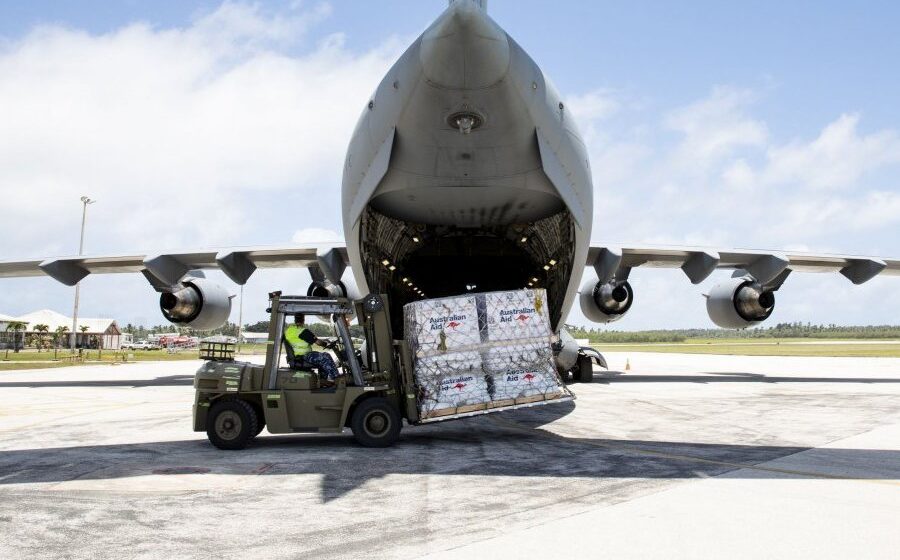The first foreign aid planes have arrived in Tonga, bearing much-needed supplies for the Pacific nation which was left devastated by a volcanic eruption and subsequent tsunami on Saturday.
New Zealand said its military plane landed at Tonga’s main airport after workers cleared ash from the runway.
Australia also confirmed the first of its relief planes had arrived.
Aid efforts had initially been hampered by ash from the volcano.
At least three people have died and communications have been crippled, and Tonga has only just begun to re-establish global contact after five days cut off from the rest of the world.
On Thursday, New Zealand’s Defence Force confirmed its C-130 Hercules plane touched down in Tonga just after 16:00 local time. It was loaded with water containers, temporary shelter kits, electricity generators, hygiene and family kits and communications equipment.
Hours afterwards, Australian defence minister Peter Dutton tweeted the first plane despatched by the Australia Defence Forces had landed, carrying “humanitarian assistance and disaster relief supplies.”
Australia said the first of its two Boeing C-17 Globemaster relief planes also had a “sweeping” device on board to help keep the runway clear.
Rescue teams and hundreds of volunteers had for days desperately worked to clear the thick layer of ash at the airport runway in the capital Nuku’alofa that had prevented planes from landing.
Volunteers used wheelbarrows and shovels, in what New Zealand’s commander of joint forces Rear Admiral Jim Gilmour called a “mammoth effort”.
“After the eruption, all of Tonga just turned grey,” Tongan journalist Marian Kupu told the BBC from the capital Nuku’alofa. “We’re talking about dogs and cars and buildings, they were all covered in ashes.”
Ms Kupu said the thickness of the ashfall made clearing the runway “difficult”, and posed a possible health threat to those engaged with the task, who were “mainly young boys”.
Both Australian and New Zealand authorities have confirmed that the aid drops will be contactless, to prevent the risk of Covid spreading to the island which has seen just one case of the virus so far in the pandemic.
“The aircraft is expected to be on the ground for up to 90 minutes before returning to New Zealand,” said New Zealand’s Defence Minister Peeni Henare.
Rear Adm Gilmour said no-contact Covid protocols were “being adhered to rigorously”, adding that relief procedures would include making sure the airplane crew would have no contact with anyone on the ground, and that everyone would be wearing personal protective equipment (PPE).
“We are very respectful that the last thing that Tonga would need now is a Covid outbreak on top of this disaster,” he added.
Australia has also said no personnel would disembark from their planes.
A New Zealand naval ship is also due to arrive in Tonga on Thursday, ahead of other supply ships.
Mr Henare earlier said the supply ships would bring more than 250,000 litres of fresh water and desalination equipment, used to separate salt from water.
“The most pressing matter that’s come through from the Tongan government is the need for fresh water,” he said.
Ms Kupu echoed similar fears that water supplies on the Pacific island nation would run out, saying they were “praying for water, for heavy rain … we do not have enough water.”
Meanwhile, the Church of Jesus Christ of Latter-Day Saints in the heavily Mormon nation says it has been providing significant shelter and clean water supplies to locals in the past days.
Communications partially restored
Contact with Tonga remains limited. A 2G connection has been restored by a telecommunications provider Digicel but the line is being overwhelmed by the demand.
The main severed undersea cable connecting the remote island nation to the outside world may also take weeks to fix.
Recently released pictures from Tonga’s consulate in the European Union, have shown the extent of the damage including cars, roads and buildings in Nuku’alofa coated in a film of ash.
Aerial images taken by the New Zealand Air Force, meanwhile, indicate that several villages have been wiped out on islands that have yet to be reached.
The explosion of the Hunga Tonga-Hunga Ha’apai volcano was felt as far away as the US. In Peru, two people drowned in abnormally high waves while beaches near the capital Lima were closed off following an oil spill.




Leave a Reply